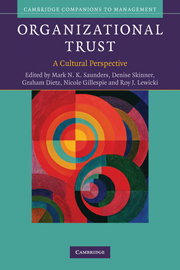Book contents
- Frontmatter
- Contents
- List of figures
- List of tables
- Note on editors
- Note on contributors
- Foreword
- Editors' acknowledgements
- Part I The conceptual challenge of researching trust across different ‘cultural spheres’
- Part II Trust across different ‘cultural spheres’: inter-organizational studies
- Part III Trust across different ‘cultural spheres’: intra-organizational studies
- 11 The role of trust in international cooperation in crisis areas: a comparison of German and US-American NGO partnership strategies
- 12 Antecedents of supervisor trust in collectivist cultures: evidence from Turkey and China
- 13 Trust in turbulent times: organizational change and the consequences for intra-organizational trust
- 14 The implications of language boundaries on the development of trust in international management teams
- 15 The dynamics of trust across cultures in family firms
- Part IV Conclusions and ways forward
- Index
- References
13 - Trust in turbulent times: organizational change and the consequences for intra-organizational trust
Published online by Cambridge University Press: 05 June 2012
- Frontmatter
- Contents
- List of figures
- List of tables
- Note on editors
- Note on contributors
- Foreword
- Editors' acknowledgements
- Part I The conceptual challenge of researching trust across different ‘cultural spheres’
- Part II Trust across different ‘cultural spheres’: inter-organizational studies
- Part III Trust across different ‘cultural spheres’: intra-organizational studies
- 11 The role of trust in international cooperation in crisis areas: a comparison of German and US-American NGO partnership strategies
- 12 Antecedents of supervisor trust in collectivist cultures: evidence from Turkey and China
- 13 Trust in turbulent times: organizational change and the consequences for intra-organizational trust
- 14 The implications of language boundaries on the development of trust in international management teams
- 15 The dynamics of trust across cultures in family firms
- Part IV Conclusions and ways forward
- Index
- References
Summary
Summary
This chapter explores trust in the context of significant corporate change. The context for the study is nine organizations experiencing significant amounts of corporate change. The chapter explores the levels of trust held by different cultural groupings. In particular, it examines trust in cultural groupings based on job grading, age and length of service, highlighting in particular how trust in the employer appears to decline based on length of service. The chapter also investigates the difference in trust levels between employees and managers within their local subcultures and the same employees' trust in their employer and senior management. The chapter explores whether local culture engenders a level of trust in line management which the broader organizational culture cannot deliver particularly at times of transformational change. The chapter interweaves illustrative qualitative material from three of the organizations researched with the overall survey results from the full sample.
We start the chapter by showing how critical trust is to the successful implementation of change programmes, before going on to argue that, despite this criticality, change-programme design fails to take account of varying attitudes and perceptions within different cultural groupings and at different cultural levels. We then present the research questions that guided our analysis before describing the methods we used to collect data, and then presenting and discussing the results.
- Type
- Chapter
- Information
- Organizational TrustA Cultural Perspective, pp. 336 - 357Publisher: Cambridge University PressPrint publication year: 2010
References
- 3
- Cited by



